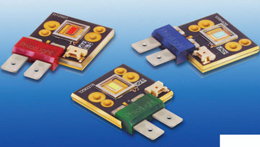It's consistently the number one complaint about using video projectors - replacing those lamps that provide all those lumens can be expensive, inconvenient, and time-consuming.
- All that may be changing. At last August's IFA show in Berlin, DLP Products introduced what they called "the industry's first home theater lamp-free projector."
- A prototype projector from Delta Electronics was shown at IFA using the PhlatLight LED light source from Luminus Devices. Luminus and Texas Instruments have been working together to increase brightness in LED-based DLP projectors by creating brighter and more efficient PhlatLight LEDs and through improvements in the DLP processing algorithms. These improvements are enabling multiple projection manufacturers such as Delta Electronics and several others to introduce DLP home theater projectors beginning later in 2008. Further developments by TI and Luminus will lead to the introduction of lampfree projectors for corporate and education markets in the future.
- "These projectors can produce outstanding images with far superior contrast and deeper blacks than lamp-based projectors," says Christian Hoepfner, vice president of products, Luminus Devices. "PhlatLight LEDs give DLP projectors a pure RGB light source, producing vivid, accurate, stable color images that will not shift or fade over time."
- Projector users will also realize cost savings from reduced power consumption enabled by LEDs, as well as the elimination of maintenance costs such as lamp replacements and filter changes required by some competing projector technologies, according to Luminus Devices. Spun out of research at the Massachusetts Institute of Technology, Luminus' PhlatLight technology is an innovative and efficient way to maximize light emission from an LED. The name "Phlat- Light" is derived from its underlying photonic lattice structures. Photonic lattices are complex arrays of sub-wavelength microstructures in a solid dielectric material that can control and radically influence the propagation of light in different directions. This new engineering discipline - combining principles of electromagnetism with the concepts of solid-state physics - has numerous applications in optics and optoelectronics.
- Luminus uses complex mathematics to optimize the intricate photonic lattice patterns, and uses proprietary processing to embed them in the PhlatLight LEDs. These sub-wavelength microstructures direct more light to the surface of the LED, and they influence the direction in which the light is emitted.
- As an additional benefit of the technology, PhlatLight LEDs reduce power consumption and the amount of hazardous waste entering the environment. Projection products using PhlatLight LEDs use far less power than comparable products illuminated by mercury-arc, high-intensity discharge, or halogen lamps, which means they help to reduce air pollution from carbon emissions. High intensity mercury arc lamps currently used in video projection contain between 10 to 50mg of mercury. These amps fade during their life and eventually burn out, requiring replacement every 2,000 to 6,000 hours. When the lamps in these products are replaced or the product is discarded at the end of its life, it must be discarded in an environmentally safe manner to avoid contaminating the environment. PhlatLight LEDs can last as long as 100,000 hours, are RoHS compliant, and are 100 percent free of hazardous materials, including lead and mercury.










